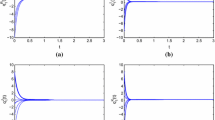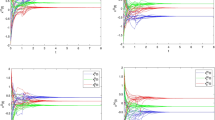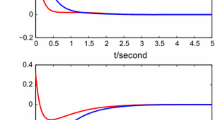Abstract
In this article, the coexistence and dynamical behaviors of multiple equilibrium points for quaternion-valued neural networks (QVNNs) are investigated, whose activation functions are discontinuous and nonmonotonic piecewise nonlinear. According to the Hamilton rules, the QVNNs can be divided into four real-valued parts. By utilizing the Brouwer’s Fixed Point Theorem and property of strictly diagonally dominant matrices, some sufficient conditions are derived to ensure that the QVNNs have at least \(5^{4n}\) equilibrium points, \(3^{4n}\) of them are locally exponentially stable, and the others are unstable. It is shown that the number of stable equilibria in QVNNs is more than that in the real-valued ones. Finally, a numerical simulation is presented to clarify the theoretical analysis is valid.





Similar content being viewed by others
References
LeCun Y, Bengio Y, Hinton G (2015) Deep learning. Nature 521(7553):436–444
Hinton GE, Salakhutdinov RR (2006) Reducing the dimensionality of data with neural networks. Science 313(5786):504–507
Krizhevsky A, Sutskever I, Hinton GE (2017) Imagenet classification with deep convolutional neuralnetworks. Communications of the ACM 60(6): 84–90
Ji S, Xu W, Yang M, Yu K (2012) 3D convolutional neural networks for human action recognition. IEEE Trans Pattern Anal Mach Intell 35(1):221–231
He K, Zhang X, Ren S, Sun J (2016) Deep residual learning for image recognition. In: Proceedings of the IEEE conference on computer vision and pattern recognition, pp 770–778
Kumpati SN, Kannan P (1990) Identification and control of dynamical systems using neural networks. IEEE Trans Neural Netw 1(1):4–27
Nie X, Cao J, Fei S (2019) Multistability and instability of competitive neural networks with non-monotonic piecewise linear activation functions. Nonlinear Anal Real World Appl 45:799–821
Zeng Z, Zheng WX (2013) Multistability of two kinds of recurrent neural networks with activation functions symmetrical about the origin on the phase plane. IEEE Trans Neural Netw Learn Syst 24(11):1749–1762
Chen X, Song Q, Li Z, Zhao Z, Liu Y (2017) Stability analysis of continuous-time and discrete-time quaternion-valued neural networks with linear threshold neurons. IEEE Trans Neural Netw Learn Syst 29(7):2769–2781
Mohamad S (2001) Global exponential stability in continuous-time and discrete-time delayed bidirectional neural networks. Phys D Nonlinear Phenom 159(3–4):233–251
Li D, Zhang Z, Zhang X (2020) Periodic solutions of discrete-time Quaternion-valued BAM neural networks. Chaos Solitons Fractals 138:110144
Zhang H, Luo Y, Liu D (2009) Neural-network-based near-optimal control for a class of discrete-time affine nonlinear systems with control constraints. IEEE Trans Neural Netw 20(9):1490–1503
Li L, Chen W (2020) Exponential stability analysis of quaternion-valued neural networks with proportional delays and linear threshold neurons: continuous-time and discrete-time cases. Neurocomputing 381:152–166
Wu A, Zeng Z (2012) Dynamic behaviors of memristor-based recurrent neural networks with time-varying delays. Neural Netw 36:1–10
Liu Y, Song Z, Tan M (2019) Multiple \(\mu \)-stability and multiperiodicity of delayed memristor-based fuzzy cellular neural networks with nonmonotonic activation functions. Math Comput Simul 159:1–17
Popa CA, Kaslik E (2018) Multistability and multiperiodicity in impulsive hybrid quaternion-valued neural networks with mixed delays. Neural Netw 99:1–18
Zeng Z, Wang J (2006) Multiperiodicity of discrete-time delayed neural networks evoked by periodic external inputs. IEEE Trans Neural Netw 17(5):1141–1151
Zeng Z, Wang J (2006) Multiperiodicity and exponential attractivity evoked by periodic external inputs in delayed cellular neural networks. Neural Comput 18(4):848–870
Zhang F, Huang T, Wu Q, Zeng Z (2021) Multistability of delayed fractional-order competitive neural networks. Neural Netw 140:325–335
Guo Z, Ou S, Wang J (2021) Multistability of switched neural networks with Gaussian activation functions under state-dependent switching. IEEE Trans Neural Netw Learn Syst 33:6569–6583
Guo Z, Liu L, Wang J (2018) Multistability of recurrent neural networks with piecewise-linear radial basis functions and state-dependent switching parameters. IEEE Trans Syst Man Cybern Syst 50(11):4458–4471
Miao J, Kou KI (2020) Quaternion-based bilinear factor matrix norm minimization for color image inpainting. IEEE Trans Signal Process 68:5617–5631
Liu Y, Zheng Y, Lu J, Cao J, Rutkowski L (2019) Constrained quaternion-variable convex optimization: a quaternion-valued recurrent neural network approach. IEEE Trans Neural Netw Learn Syst 31(3):1022–1035
Xia Z, Liu Y, Lu J, Cao J, Rutkowski L (2020) Penalty method for constrained distributed quaternion-variable optimization. IEEE Trans Cybern 51(11):5631–5636
Chen H, Wang T, Cao J, Vidal PP, Yang Y (2021) Dynamic quaternion extreme learning machine. IEEE Trans Circuits Syst II Express Briefs 68(8):3012–3016
Wang Y, Kou KI, Zou C, Tang YY (2021) Robust sparse representation in quaternion space. IEEE Trans Image Process 30:3637–3649
Liu Y, Zhang D, Lu J, Cao J (2016) Global \(\mu \)-stability criteria for quaternion-valued neural networks with unbounded time-varying delays. Inf Sci 360:273–288
Liu Y, Zhang D, Lou J, Lu J, Cao J (2017) Stability analysis of quaternion-valued neural networks: decomposition and direct approaches. IEEE Trans Neural Netw Learn Syst 29(9):4201–4211
Liu Y, Zhang D, Lu J (2017) Global exponential stability for quaternion-valued recurrent neural networks with time-varying delays. Nonlinear Dyn 87(1):553–565
Hu J, Zeng C, Tan J (2017) Boundedness and periodicity for linear threshold discrete-time quaternion-valued neural network with time-delays. Neurocomputing 267:417–425
Zhang D, Kou KI, Liu Y, Cao J (2017) Decomposition approach to the stability of recurrent neural networks with asynchronous time delays in quaternion field. Neural Netw 94:55–66
Chen X, Song Q, Li Z (2017) Design and analysis of quaternion-valued neural networks for associative memories. IEEE Trans Syst Man Cybern Syst 48(12):2305–2314
Song Q, Chen X (2018) Multistability analysis of quaternion-valued neural networks with time delays. IEEE Trans Neural Netw Learn Syst 29(11):5430–5440
Yang X, Li C, Song Q, Chen J, Huang J (2018) Global Mittag-Leffler stability and synchronization analysis of fractional-order quaternion-valued neural networks with linear threshold neurons. Neural Netw 105:88–103
Cheng CY, Lin KH, Shih CW (2007) Multistability and convergence in delayed neural networks. Phys D Nonlinear Phenom 225(1):61–74
Nie X, Cao J (2009) Multistability of competitive neural networks with time-varying and distributed delays. Nonlinear Anal Real World Appl 10(2):928–942
Wang L, Lu W, Chen T (2010) Coexistence and local stability of multiple equilibria in neural networks with piecewise linear nondecreasing activation functions. Neural Netw 23(2):189–200
Nie X, Cao J, Fei S (2013) Multistability and instability of delayed competitive neural networks with nondecreasing piecewise linear activation functions. Neurocomputing 119:281–291
Hopfield JJ (1984) Neurons with graded response have collective computational properties like those of two-state neurons. Proc Natl Acad Sci 81(10):3088–3092
Chen X, Zhao Z, Song Q, Hu J (2017) Multistability of complex-valued neural networks with time-varying delays. Appl Math Comput 294:18–35
Zeng Z, Huang DS, Wang Z (2005) Memory pattern analysis of cellular neural networks. Phys Lett A 342(1–2):114–128
Zeng Z, Huang T, Zheng WX (2010) Multistability of recurrent neural networks with time-varying delays and the piecewise linear activation function. IEEE Trans Neural Netw 21(8):1371–1377
Huang Y, Zhang H, Wang Z (2014) Multistability of complex-valued recurrent neural networks with real-imaginary-type activation functions. Appl Math Comput 229:187–200
Wang L, Chen T (2012) Multistability of neural networks with Mexican-hat-type activation functions. IEEE Trans Neural Netw Learn Syst 23(11):1816–1826
Wang Z, Guo Z, Huang L, Liu X (2017) Dynamical behavior of complex-valued Hopfield neural networks with discontinuous activation functions. Neural Process Lett 45(3):1039–1061
Liang J, Gong W, Huang T (2016) Multistability of complex-valued neural networks with discontinuous activation functions. Neural Netw 84:125–142
Nie X, Zheng WX (2015) Multistability and instability of neural networks with discontinuous nonmonotonic piecewise linear activation functions. IEEE Trans Neural Netw Learn Syst 26(11):2901–2913
Liu Y, Huang X, Li Y, Shen H (2021) Multistability of Hopfield neural networks with a designed discontinuous sawtooth-type activation function. Neurocomputing 455:189–201
Xu D, Tan M (2018) Multistability of delayed complex-valued competitive neural networks with discontinuous non-monotonic piecewise nonlinear activation functions. Commun Nonlinear Sci Numer Simul 62:352–377
Huang Y, Zhang H, Wang Z (2012) Multistability and multiperiodicity of delayed bidirectional associative memory neural networks with discontinuous activation functions. Appl Math Comput 219(3):899–910
Tan M, Liu Y, Xu D (2019) Multistability analysis of delayed quaternion-valued neural networks with nonmonotonic piecewise nonlinear activation functions. Appl Math Comput 341:229–255
Tong WT (1977) Distribution of eigenvalues of a class of matrices. Acta Math Sin 20(4):272–275
Khalil HK (2002) Nonlinear systems, 3rd edn. Patience Hall, p 115
Acknowledgements
The research is supported by grants from the National Natural Science Foundation of China (Nos. 62172188, 52072130) and the Natural Science Foundation of Guangdong Province in China (No. 2021A 1515011753).
Author information
Authors and Affiliations
Contributions
WD: Writing—Original Draft, Formal analysis. JX: Visualization. MT: Writing—Review & Editing.
Corresponding author
Ethics declarations
Conflict of interest
The authors declare that they have no conflict of interest.
Additional information
Publisher's Note
Springer Nature remains neutral with regard to jurisdictional claims in published maps and institutional affiliations.
Rights and permissions
Springer Nature or its licensor (e.g. a society or other partner) holds exclusive rights to this article under a publishing agreement with the author(s) or other rightsholder(s); author self-archiving of the accepted manuscript version of this article is solely governed by the terms of such publishing agreement and applicable law.
About this article
Cite this article
Du, W., Xiang, J. & Tan, M. Multistability of Quaternion-Valued Recurrent Neural Networks with Discontinuous Nonmonotonic Piecewise Nonlinear Activation Functions. Neural Process Lett 55, 5855–5884 (2023). https://doi.org/10.1007/s11063-022-11116-w
Accepted:
Published:
Issue Date:
DOI: https://doi.org/10.1007/s11063-022-11116-w




